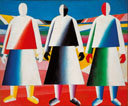Kasimir Malevich
dal 9/7/2006 al 9/9/2006
Segnalato da
9/7/2006
Kasimir Malevich
Museo de Bellas Artes, Bilbao
The exhibition gathers over 100 works by the founder of suprematism and one of the key figures in the European avant-garde. An overall, chronological view of the artist’s work that includes his first impressionist sketches, symbolist and fauvist paintings, images of peasants from 1911 and 1912 and cubo-futurist compositions. It also shows the preparatory drawings for the costumes and the scenery of the opera 'Victory over the Sun', 11 "architectons" and a wide selection of documentary material.

For the first time in our country the exhibition gathers over one hundred
works by Kasimir Malevich (Kiev, 1879-Saint Petersburg, 1935), the founder
of suprematism and one of the key figures in the European avant-garde.
Among the institutions which have collaborated on the project are the
Russian State Museum of Saint Petersburg, the Tretyakov Gallery of Moscow
and the National Museum of Modern Art - the Georges Pompidou Centre in
Paris.
Malevich is one of the most important artists in the 20th century. His
suprematist theories and works paved the way towards a type of art freed
from the burden of the object and, consequently towards total abstraction.
The influence of his paintings, drawings, architectural designs and
writings can still be felt today and it can be noted particularly in
several generations of Basque artists of whom Jorge Oteiza is a paradigm.
The exhibition, which gives us an overall, chronological view of the
artist’s work, includes his first impressionist sketches, symbolist and
fauvist paintings, images of peasants from 1911 and 1912 and cubo-futurist
compositions. It also shows the preparatory drawings for the costumes and
the scenery of the opera, Victory over the Sun, preliminary to total
abstraction and the suprematist works among which can be seen the
emblematic Red Square (1915) and Black Square (c. 1923) from the Russian
State Museum of Saint Petersburg, and a good number of post-suprematist
works. The selection ends with works carried out towards 1930 which are
representative of the return to figuration and peasant iconography. Also
on exhibition are eleven “architectons" and a wide selection of
documentary material such as books, photographs, lithographs and the
artist’s original testament.
Image:Girls in a field, 1928-29. Russian State Museum, St. Petersburg (c) 2006,
State Russian Museum, St. Petersburg
Opening: 10 July 2007
Museo de Bellas Artes
Plaza del Museo 2 - Bilbao
Hour: Tue - Sat 10 - 20, Closed on Monday, Sunday: 10 - 14



